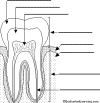Biology
|
Human diet and digestion
-know that humans need carbohydrates (sugar and starch) and fats for energy; proteins for energy, building
new cells,making enzymes and defense against disease – be able to describe any one health problem resulting from a poor diet which is important in the student’s own country, discuss the reasons for
this problem and suggest ways in which it could be – know good dietary sources of carbohydrates, fats
and proteins
– know how to perform the Benedict’s test for reducing
sugars,the iodine test for starch, and the biuret test for proteins
– know the functions of vitamin C, vitamin D, iron and
calcium in the human body, state good sources of these nutrients and
describe the symptoms of diseases resulting from their deficiency in the
diet – understand that the alimentary canal is a tube passing right through the body, and that nutrients cannot be used by cells until they have passed through the walls of the alimentary canal
– be able to label the following parts on a diagram of
the human digestive system: mouth, esophagus, stomach, small intestine,
colon, rectum, anus, liver process is called absorption and happens in
the small intestine –know that amylase breaks down starch to sugar in the mouth and
–understand that, before absorption can occur, large
pieces of food must be broken into small ones, and large molecules into
small ones, and that this process is called digestion small intestine;
protease breaks down proteins to amino acids in the stomach and small
intestine; lipase breaks down fats to fatty acids and glycerol in the
small intestine
–be able to describe the structure of a tooth and
describe the roles of teeth in digestion –know that amino acids, sugar, fatty acids and glycerol are absorbed into the blood through the walls of the small intestine
–know that large molecules are broken down into small ones by enzymes in the alimentary canal and that water is absorbed in the colon |
|
|
Chemistry Electrolysis − be able to
describe electrolysis as the breaking down of a compound by the passage
of direct electric current − know, in
general terms, the apparatus and materials needed for electrolysis
|
|
Useful Links:





